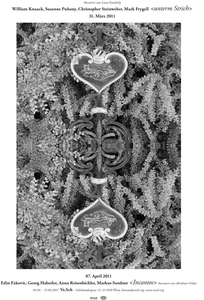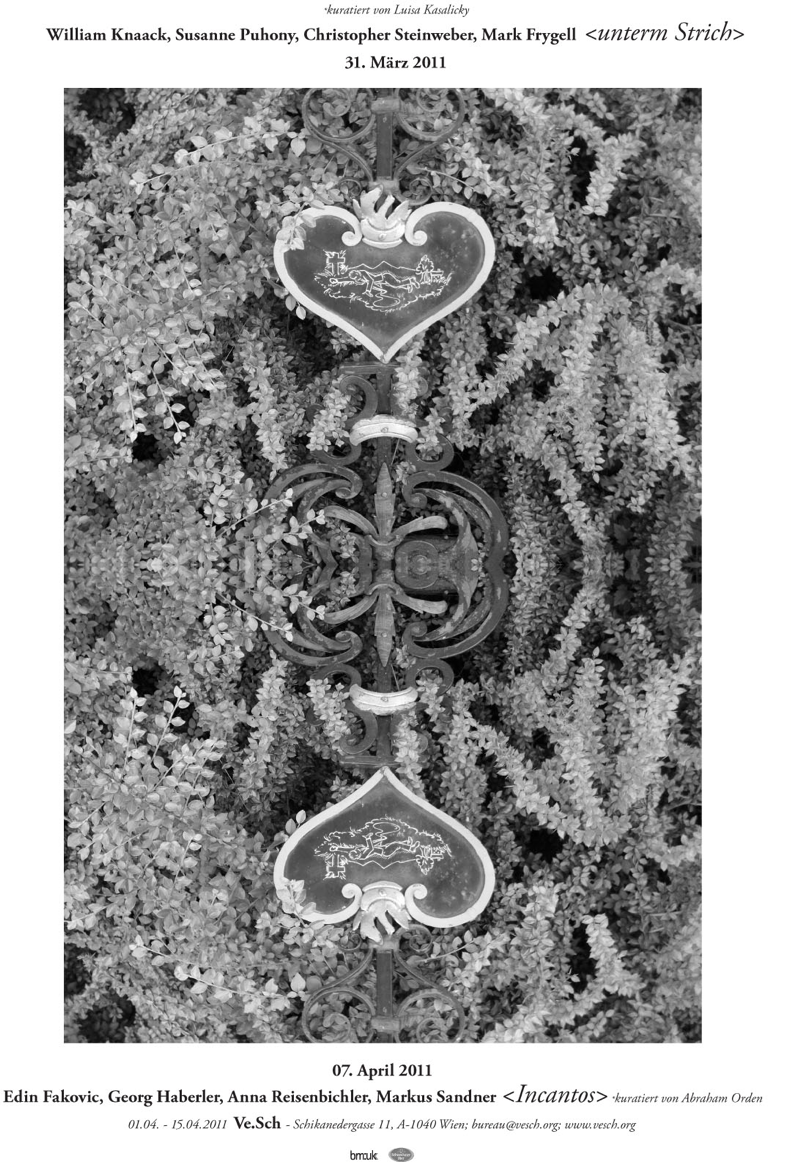<unterm Strich> und <Incantos>
2 Austellungen des Instituts für bildende Kunst, Abstrakte Malerei, Professor Erwin Bohatsch
Teil I kuratiert von Luisa Kasalicky mit William Knaack, Susanne Puhony, Christopher Steinweber, Mark Frygell
Teil II kuratiert von Abraham Orden (Eröffnung 7. April, 19.00 Uhr) mit Edin Fakovic, Georg Haberler, Anna Reisenbichler, Markus Sandner
<unterm Strich>
Christopher Steinweber im Gespräch mit Arnold Reinthaler
Wie sieht deine Arbeit konkret aus?Du hast mir erzählt von der Idee einer vervielfältigten Skulptur. Was heißt das konkret?
Es werden mehrere Skulpturen als Reproduktionen eines Prototypen sein. Ich mache etwas Intuitives, was sogar wie zufällig gestellt, gestapelt, gelehnt, bemalt aussieht. Demnach löscht die Wiederholung der Erstlingsskulptur den Faktor Intuition und Zufall komplett aus.
Ästhetik und Funktion, wie formulierst du das?
Der Ästhetik messe ich keinen großen Stellenwert bei. In dem Fall ist das Medium Skulptur ein Werkzeug. Wie der Hammer aussieht, hat für mich einen sekundären Stellenwert.
Das Original wird so lange wegrelativiert, bis es völlig verschwindet, etwa so wie beim altbewährten Gesellschaftsspiel Stille Post. Ist das Original auf der Flucht?
Ob das Original in der Masse verschwindet, oder ob die Masse das Original ist, die Frage bleibt offen, und das ist auch gut so.
Mark Frygell im Gespräch mit Birgit Knoechl
You work in many different kinds of mediums. Do you see a line in your work that connects it?
It all derives from me so it is connected in this way but I am also very process-based. Often I start with painting, quite intuitively, and then work with text or different kinds of mediums. I try to switch between different kinds of crafts. I could get this original, very mundane object,
something you see every day and then try to find out, why this is interesting, and build a new object out of it. So, it is very personal and reflective.
So then you find shape, material and structure interesting and then you go on "why am I interested in this? How can I work with this?"
Yes, and then I start to connect it with different texts, ideas or other material and the work starts to take form. I mean, the way I start is always very banal, simple, and then gradually becomes more serious as I work with it.
And is it important that the viewer gets your view of things as the input?
No. I mean I do not want to close down my work and connect it too much to ways of thinking or ways of looking at objects. It has an intellectual process behind it, but it is not important that you "get it". I want to keep it open to different people from different structures.
When did you start?
I started as a tattoo apprentice but needed to improve my drawing so I entered a preparatory art school, and after one year I drifted towards fine art. It was something you could find something in a different way. It was more open and felt more interesting. So, this would be my fourth year doing fine art, but I have a background in the punk-scene, where you are encouraged to be creative and no one cares if you suck. So I have been working creatively since I was quite young playing music, doing fanzines, drawing record covers and so on.
Your work seems to often be quite repetitive.
Yeah, if I, for example, figure out a painting I want to do I would make 10 out of them. I find it hard to describe but every painting after the first one is at one point a copy but on the other hand a new painting. It can never be completely the same. It is also this thing of creating an object.
For example this work with the stone panels I did. I found these stone panels and it made no sense for me to make separate paintings on the same kind of stone. I wanted to make "this" stone painted many times in the same way. Something like the object becomes a new object that also exists in many copies. Hm, I'm quite used to describing my work by describing how it was made. For me this is the easiest way.
Yes, because you seem to be quite interested in structure and process. That how something is made and the structure of an object is interesting. As you mentioned before talking about repetition that something will be the same but never exactly the same. That this "Mani" is forcing you through the work?
Yes, I think so. Also, when you are so used to see duplicates, these factory made objects, it becomes a play with this at some level. There is something rewarding in working like a machine but when I do it as a human being it becomes different.
Do you know what you will exhibit?
I am working on many different works now, but don't know what I will use. I usually try to keep many different works going and plan a lot in advance what problems could arise, and after I have worked some on each one of them I know which ones that I will invest my full time in and which ones who are works to be able to create what I consider to be the "artwork". So you have a lot of work to do? Ha ha, yes.
Susanne Puhony im Gespräch mit Armin Baumgartner
Die Arbeiten bestehen hauptsächlich aus geschenktem und gefundenem Material, aus dem du fragile Zeichnungen im Raum fertigst. Welchen Stellenwert hat für dich das Blickfeld?
Ich möchte die Perspektive des Betrachters so verschieben, dass er in meinem Zwinkern steht. Anwesend und abwesend sein gleichzeitig. Und wie siehst du den Blick? Ich schau einfach hin. ... und her.
Geht es dir um das poetische Verweigern der Wirklichkeit, um so in eine andere Erzählebene zu kommen, Erzählungen von Dingen möglich zu machen, die nicht denkbar sind?
Ja, es ist die Ahnung eines alternativen Sehens. Ich will den Moment, den der Blick mit dem Raum spannt, sichtbar machen. Es wird alles möglich Denkbare zum realen Teil der Arbeit.
Kaum glaubt man, einen Ansatzpunkt zu fassen, entzieht er sich wieder.
Da setzt die Arbeit ein, ist auch nur kurz da, und dann auch gleich wieder weg. Ich möchte Anfang und Ende weglassen und dadurch alles beweglich halten. Der Raum hingegen bleibt.
Armin Baumgartner, Schriftsteller; Birgit Knoechl, Künstlerin; Arnold Reinthaler, Künstler; Christian Weigl, Künstler
*Luisa Kasalicky, Künstlerin. Assistentin der Klasse für Abstrakte Malerei, Erwin Bohatsch. Akademie der bildenden Künste, Wien
<Incantos>
*The Window* by Robert Creeley
Position is where you
put it, where it is,
did you, for example, that
large tank there, silvered,
with the white church along-
side, lift
all that, to what
purpose? How
heavy the slow
world is with
everything put
in place. Some
man walks by, a
car beside him on
the dropped
road, a leaf of
yellow color is
going to
fall. It
all drops into
place. My
face is heavy
with the sight. I can
feel my eye breaking.
*Abraham Orden betreibt den Ausstellungsraum Song Song und ist Assistent der Klasse für Abstrakte Malerei, Erwin Bohatsch, Akademie der bildenden Künste, Wien
Liste der Einträge
-
<unterm Strich> und <Incantos>
2 Austellungen des Instituts für bildende Kunst, Abstrakte Malerei, Professor Erwin Bohatsch
Teil I kuratiert von Luisa Kasalicky mit William Knaack, Susanne Puhony, Christopher Steinweber, Mark Frygell
Teil II kuratiert von Abraham Orden (Eröffnung 7. April, 19.00 Uhr) mit Edin Fakovic, Georg Haberler, Anna Reisenbichler, Markus SandnerEröffnung Teil I
Ve.Sch, Schikanedergasse 11, A-1040
Akademie

